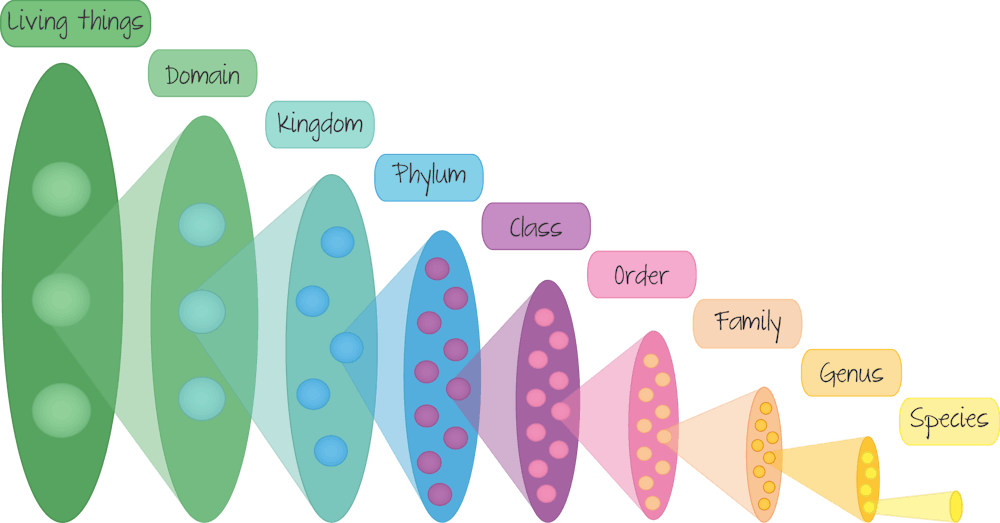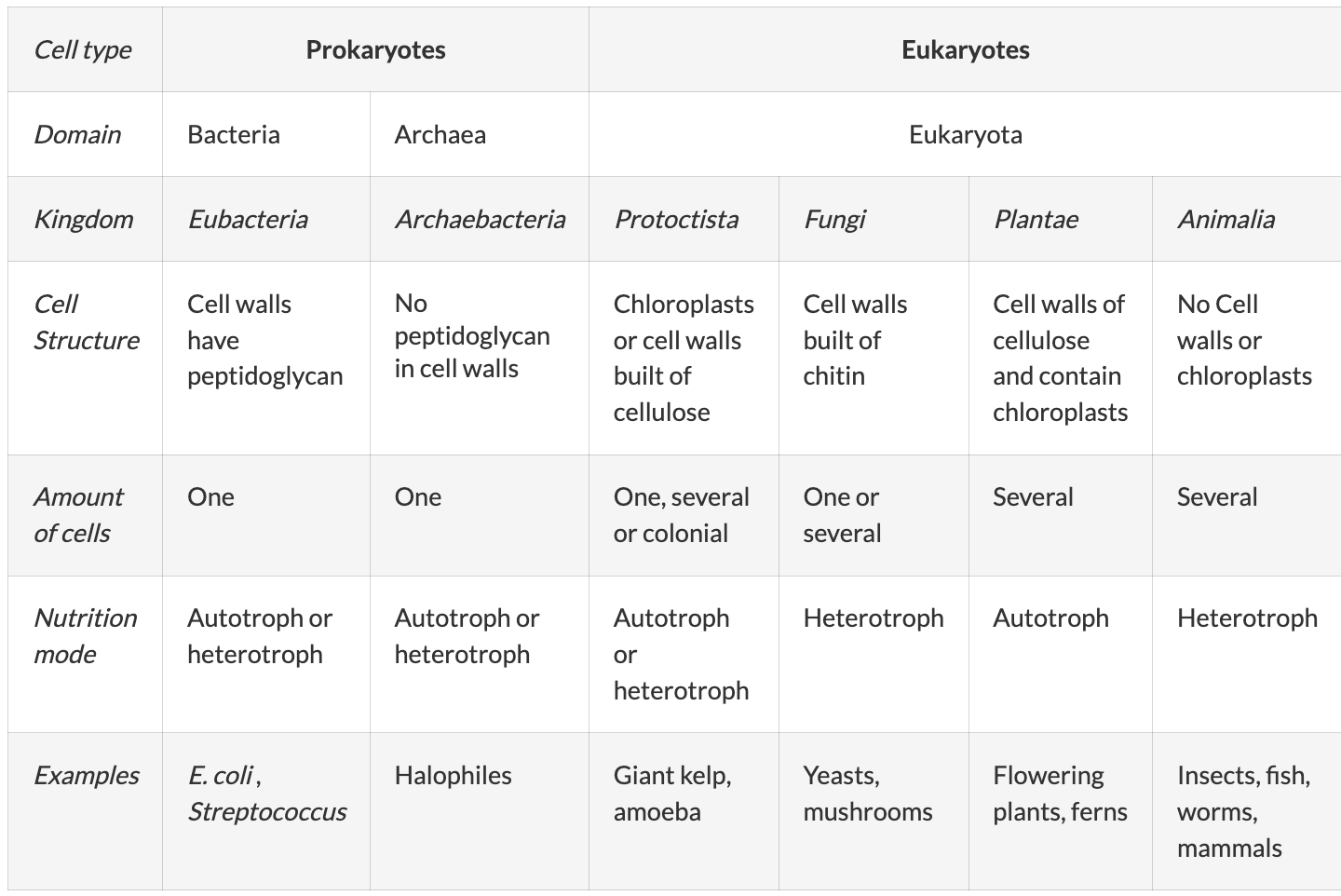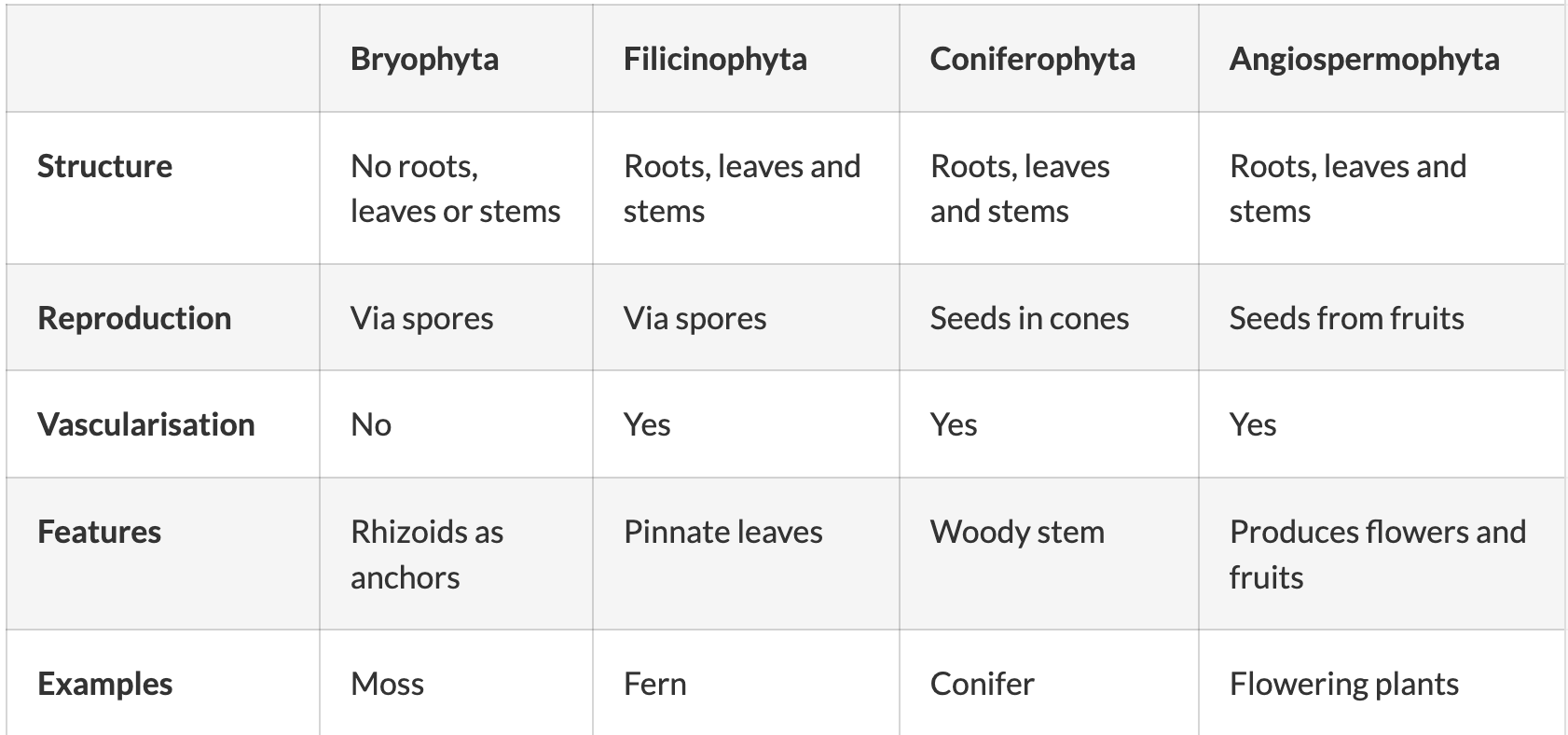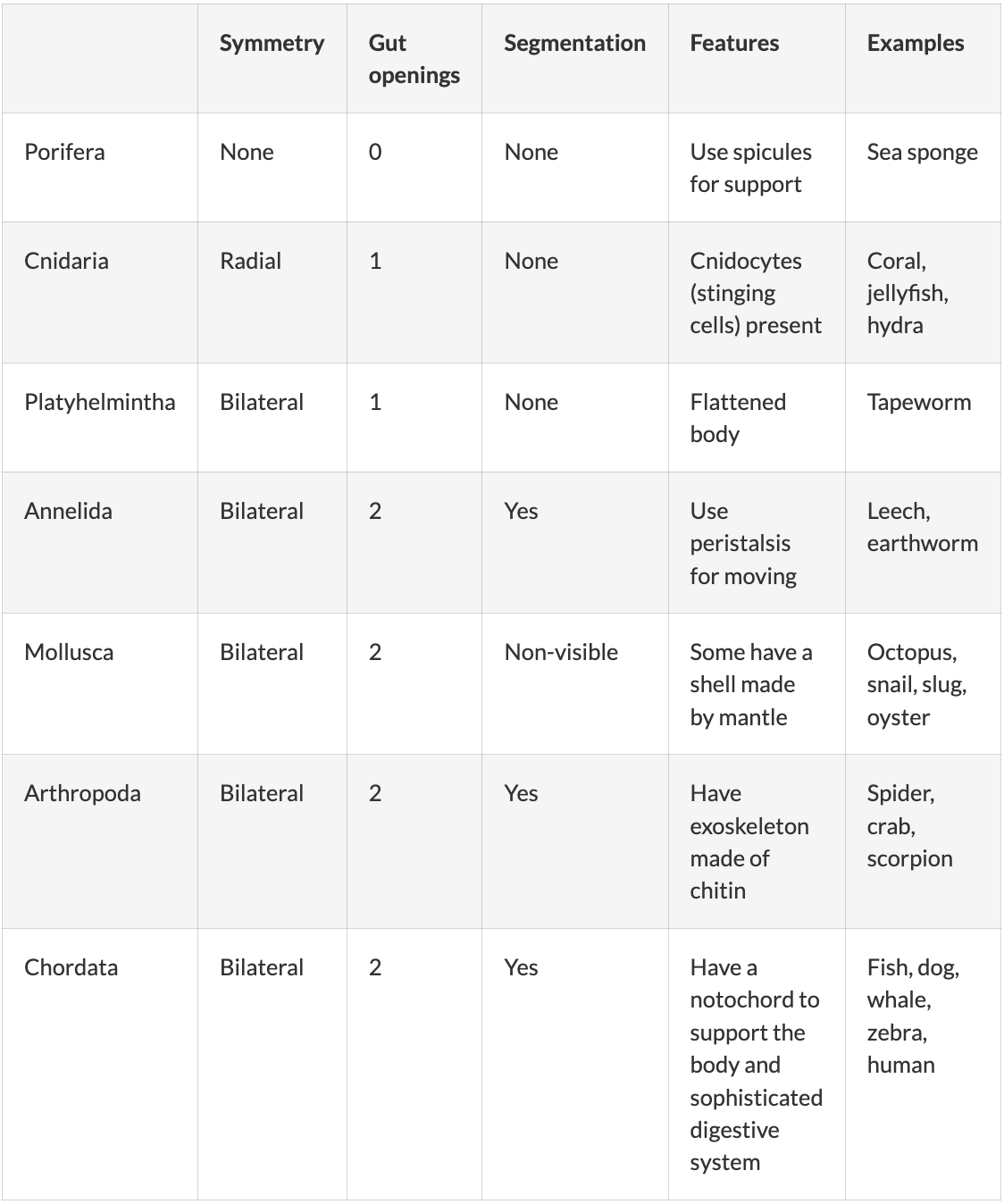Unit 5.3: Classification of biodiversity
1/41
There's no tags or description
Looks like no tags are added yet.
Name | Mastery | Learn | Test | Matching | Spaced |
|---|
No study sessions yet.
42 Terms
Essential idea
Species are named and classified using an internationally agreed system — binomial system
combination if genus + species name
ensure that despite different languages, it can be identified easily
latin or classical greek cause unchanging languages
newly discovered organisms can be classified
recognized genealogical relationships between organisms
genus
a group of species that share common characteristics but may not be able to interbreed.
e.g. Macropus or big foot for kangaroos with big hind legs
capital letter, written first, italics/underlined
abbreviated after used 1 in text
species
a group of organisms in the same genus that are able to interbreed to produce fertile offspring
lowercase letter, written second, italics/underlined
subspecies
Organisms placed in the same species and subspecies are able to interbreed to have fertile offspring
e.g. Macropus giganteus giganteus and the Macropus giganteus tasmaniensis
Both eastern gray kangaroo, able to interbreed but not often because geographically isolated
taxonomy
science branch concerned with classification of living organisms
virus is not
dear king philip came over for good soup
each higher level includes larger group of organisms — hierarchy of taxa
more taxa shared, more in common
only sharing species level taxa can interbreed
eukaryotes: species → genus → family → order → class → phylum → kingdom

evolution of domain classification
before DNA sequences: divided into prokaryotes (aka monera) and eukaryotes
in 1977 using DNA sequencing, Carl Woese:
prokaryotes had 2 separate ancestors
THUS: 3 lines of living things/three domains namely bacteria (eubacteria), archea, and eukaryota
(Eu)bacteria
histones: absent
cell membrane: glycero-esters of lipids, D-form of glycerol
cell wall: peptidoglycan
lacking nucleus
usually disease causing or pathogenic
archea
histones: present in some species
cell membrane: glycerol-ether lipids, L-form of glycerol
cell wall: not made of peptidoglycan
usually no nucleus and in extreme conditions
eukaryota
histones: present
cell membrane: Glycerol ester lipids, D-form of glycerol
cell wall: Not made of peptidoglycan, sometimes absent
with nucleus
phylogenetic tree

further kingdoms of 3 domains
(picture)
domain eukaryota’s kingdoms: protoctista, fungi, plantae, animalia

natural classification
genus & higher taxa consist of species evolving from one common ancestral species
allows prediction of characteristics shared
allows classification of newly discovered
artificial classification: organisms grouped by basic characteristics not showing evolutionary relationships — e.g. with wings
Blue Whale classification
domain: eukaryota
kingdom: animalia
phylum: chordata
class: mammalia
order: cetacea
family: Balaenopteridae
genus: Balaenoptera
species: musculus
garlic classification
domain: eukaryota
kingdom: plantae
phylum: Magnoliophyta
class: Liliopsida
order: Asparagales
family: Amaryllidaceae
genus: Allium
species: sativum
If organisms A, B and C belong to the same class but to different orders, and if organisms D, E and F belong to the same order but to different families, which of the following pairs of organisms would be expected to be the most similar?
D & F
Class is a higher taxon of many orders. So if organism D, E and F belong to an order they would share more characteristics than organisms A, B or C that share the same class.
lower taxa share more characteristics as more groups are added the higher taxa
dichotomous key
series of paired opposing statements which guide the user to the identity (or allows the classification) of an item or organism.
yes or no questions and direction
allows narrowing down to genus then species
Kindom Platae’s four phyla:
bryophytes, filicinophytes, coniferophytes and angiospermophytes

Bryophytes
mosses, liverworts, hornworts
non-flowering
1-10cm tall
grow closely in clumps or mats in damp & shady
no vascular tissue → small because can’t transport water throughout, absorbs from surroundings
produce sporangia — spore capsules above plant on thin stalks
when saturated → released & settle in soil → form gametophyte → combine forming zygote → develop into sporangia
no roots, have rhizoids — thin thread-like outgrowths holding them into soil. not for absorption
not “true leaves” (no vascular tissue) but has chlorophyll & contain photosynthesis
help make soil fertile, prevent flooding, pioneer species
vascular tissue
transports water and sugars throughout the plant.
types: xylem & phloem
rhizoids
small root-like structures that help bryophytes to attach to the soil.
xylem
type of vascular tissue composed of non-living cells that transport water.
phloem
type of vascular tissue that transports sugars throughout the plant.
Filicinophytes
ferns & horsetails
shallow roots
leaves develop in fronds (large divided leaf) / pinnate leaves (divided into leaflets)
primitive vascular system with xylem & phloem
small tree-like form but no woody stems
spores produced in clusters (sori) on underside of fronds
burst & release to soil
with right conditions → produce gametophyte called prothallus → zygote after fertilization
Coniferophytes
aka conifers
gymnosperms — seeds not enclosed in ovary
cone-bearing seed trees with vascular tissues
wood & needle-like leaves with thick waxy cuticle
monoecious plants — produce male & female reproductive structurs/cones on same plant
sexual reproduction be releasing pollen from male cones → carried by wind to female cones → stick to ovules where fertilization occurs → form seeds
essential producers & provide shelters
cedars, douglas fir, cypress, redwoord, spruce, and yew
angiospermophytes
flowering
classified into monocotyledons or dicotyledons
vascular tissue
developed roots, stems & leaves — varying structure
huge diversity in this phylum — small to massive
fruit trees & crop plants like wheat, cabbage
stem may be woody in shrubs & trees
reproduction: transfer of pollen grains from anthers to stigma of carpels → fertilization of ovules in ovary → ovules form seeds, ovary maybe form fruit
fruit help disperse seeds once ripen and fall to the ground or eaten
producers, often forming mutualistic relationships
animal kingdom phyla:
porifera, cnidaria, platyhelminthes, annelida, mollusca, arthropoda and chordata.
one way to separate: symmetry
bilateral symmetry
radial symmetry (symmetrical along multiple planes stemming from center)
no symmetry

porifera
sponges
full of pores & channels allowing water circulaiton
no mouth or anus
filter water for plankton as food without dogestive system
no nervous or circulatory system but may form skeleton of calcium carbonate or silic
asymmetrical
can sexually or asexually produce
typically hermaphroditic — produce male & female gametes
during spawning: release only egg or sperm at one time → fertilized by mixing with other gamete from another individual (genetic variation) → embryo formed → larva develops → settles on ocean bottom & attaches
OR budding: grow, break off, attaches elsewhere
cnidaria
hydras, jellyfish, corals, sea anemones
mouth, no anus as digestive system
feeding: single opening into body cavity where digestion & waste disposal occurs
simple nervous stem of ganglia (decentralized nerve net)
no circualtory system
maintain shape with hydrostatic skeleton — including musclar cavity filled with water
2 basic body forms:
swimming medusae — gelatinous umbrella-shaped bells with trailing tentacles
sensile (attached to rocks/substrates) polyps
both radial symmetry, mouths surrounded by tentacles bearing cnidocytes (specialized cells mainly to capture prey)
reproductive: sexual & asexual
asexual: medusa form buds off cnidarian
sexual: medusa makes egg & sperm with other cnidarians → fertilization → zygote → blastula → planula → settles as polyp (?)
platyhelminthes
flatworms
simple digestive system
mouth attached to pharynx and gastrovascular cavity, no anus
absorb nutrients from environment or directly feeding using pharynx
flattened body shape increases SA:V for absorption
often parasites inside animals or in water
nervous systems possess brain connected to ganglia, some with eyespots (detects light)
hydrostatic skeleton to keep shape & move
bilateral symmetry
three tissue layers
no body cavity
hermaphrodites
sexually by injecting sperm sells into another
asexually through budding, if cut both can regenerate into new individual
annelida
segmented worms and leeches
complete digestive system: mouth, pharynx, esophagus, gizzard, intestine, anus
gizzard to mash food before entering rest of digestive
closed circulatory system w/ blood vessels carrying nutrients & oxygen
nervous systems: brain attached to nerve cords running along length & connect to ganglia
hydrostatic skeleton — using water surrounded by muscles for shape & movement
bilateral symmetry, ringed segments (some specialized)
marine, tidal zones, hydrothermal vents, freshwater, moist terrestrial
e.g. earthworms
for soil aeration
hermaphrodites
but w/ diff sexes
budding
mollusca
85k+ species
snails, slugs, octopus, oysters, mussels
mouth & anus with radula (raspy tongue-like)
3 common features:
mantle with cavity for breathing & excretion
radula
simple nervous system
open circulatory system — blood pumped from heart to surrounding tissues
bilateral symmetry
some with calcareous shell (mostly calcium carbonate) formed & repaired by mantle
aquatic & terrestrial
recyclers of nutrients or indicators
most have separate sexes & sexual reproduction
some hermaphrodites
others asexually through parthenogenesis (female egg develpps into clone without fertilization)
arthropoda
largest animal phylum — insects, crustaceans, spiders, scorpions, etc
developed digestive system: mouth, pharynx, esophagus, stomach, colon and anus — feed in many ways since variety
nervous system: brain attached to nerve cords & ganglia
open circulatory system
exoskeleton of chitin (carbohydrate)
when growing → shed exoskeleton → form new aka moulting
vulnerable phase
exoskeleton limits size
bilateral symmetry
jointed appendages (legs) & segmented bodies
found in most ecosystems
part of food chain, decomposers and often form mutualistic relationships
most terrestrial arthoprods reproduce sexually with internal fertilization
aquatic athroprods usually reproduce externally
some asexually — parthenogenesis
chordata
posses notochord — cartilaginous rod supporting nerve cord
hollow dorsal nerve cord
mammals, fish, amphibians, reptiles, birds, Tunicata (sea squirts) and Cephalochordata (the lancelets)
ingest food, developed digestive system w/ separate mouth & anus
nervous system main characteristic to categorize in this phylum
closed circulatory system — heart & blood vessels transporting nutrients & oxygen
all bilateral symmetry
most internal skeleton for support & movement
diverse group in both terrestrial & aquatic
commonly known as vertebrates
largest class: Osteichthyes or the bony fish
reproduce many diff ways
sexually, asexually (budding or parthenogenesis)
which animal phyla have bilateral symmetry
Platyhelmintha
Annelida
Mollusca
arthropoda
chordata
Porifera none, cnidaria radial
number of gut openings for animal phyla
porifera: 0
cnidaria & platyhelmintha: 1
annelida, mollusca, arthopoda, chordata: 2
segmentation of animal kingdom phyla
porifera, cnidaria, platyhelmintha: none
annelida, arthopoda, chordata: yes
mollusca: non-visible
vertebraes
subphylum of chordata
characterised by vertebral column/backbone supporting spinal cord
subdivided into 7 classes
five types of vertebrates: fish, amphibians, reptiles, birds and mammals
fish
3 classes: jawless fish, cartilaginous fish, and bony ray-finned fish
fish: animal with scales covering & protecting body
lack limbs with digits
live entirely in water
cold blooded/ectotherma — don’t maintain own body temp
hearts: 2 chambers
bony ray-finned: largest of 3, fins supported with spines, gills covered by operculum, gill slit, swim bladder (contain gasses for buoyancy)
external fertilization
don’t usually care for offspring after hatching
amphibia
frogs, newts, salamanders
thin wet skin
habitat variety: terrestrial (land-living), arboreal (in trees) or freshwater aquatic
ectothermic
heart: 3 chambers
skin as secondary respiratory surface (breathe through skin)
rudimentary lung sacs allowing gas exchange
larval stage: gills for gas exchange since in water
4 limbs with digits
many eggs coated in jelly for protection
eggs laid → external fertilization → hatch & leave offspring for most
poison dart frogs carry offspring
reptilia
turtles, corcodiles, snakes, lizards
scales of keratin
adapted to living on land
many have 4 limbs with digits
ectothermic/cold-blooded — regulate temp using external sources (sun baking)
heart: 3 chambers
developed lungs (help land-living)
reproduce through internal fertilization, lay soft shell eggs, don’t usually parent
crocodiles do for short time
aves (birds)
hawks, sparrows, flamingos
covered with developed scales aka feathers of keratin
many environments
endothermic/warm-blooded - regulate own temp
help live in more diverse habitats
heart: 4 chambers
4 pentadactyl limbs: 2 legs, 2 wings
most wings for flying
lungs for air ventilation
need many oxygen cause much energy for flying
internal fertilization & lay eggs
care for young: feeding & nesting
mammalia
platypus, bears, cats, humans
skin covered in hair (follicles) or fur
skin also has sweat glands
habitat on land and in water
warm-blooded/endothermic
breathing through lungs
heart: 4 chambers
four pentactyl limbs
middle ear bones & mammary female glands
mostly give birth to live young (5 lay eggs(
internal fertilization
parent offspring for most development